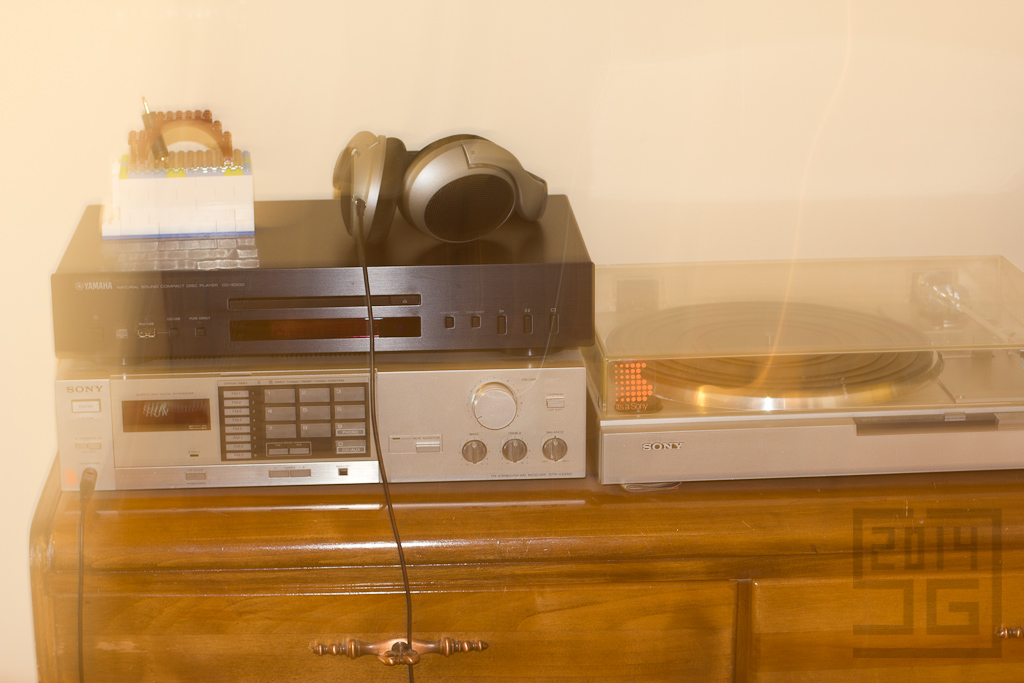You may have noticed that my blog posts have been rather thin of late. If you haven't, well I'm terribly hurt you haven't been mashing refresh on a daily basis and sighing at the appearance of the post you've already seen 32 times. I have been working on a few things, but the one that has captured my attention most readily and frequently over the past few months has been the idea of a Raspberry Pi based music streaming system. Recently I've made enough progress that I thought I should share what I've been up to and how it's working out so far.
Here's my stereo system. The headphones I got first. I was immediately disappointed to find that I needed more components to really get the audio thing going. So next I got the turntable and receiver from a friend, (thanks Andrea!) and of course speakers. Later I got a CD player. I thought that was pretty good for a Hi-Fi system (incidentally the term WiFi is a play on HiFi, which doesn't make any sense to me... wireless fidelity?).
But what's this new white box on the CD player with a weird brown arch on it?

An aside: Please ignore the creative license in the photography. I was messing around and accidentally stumbled on what I think is a neat 70s film look. No? It looks like an amateur who doesn't know how to use on-camera flash? Fair enough.
Wait, hang on, this white box appears to be made of lego (a collective noun). And the brown stuff is a cleverly constructed headphone-adapter-holder and handle! Handle? Why yes...
The top comes off! And what's inside? Well, if you said a Raspberry Pi, then you are cheating because I told you at the beginning of the post and because you can't see the Raspberry Pi in the below image. What you can actually see is a digital to analog converter (DAC) by IQaudIO that is sitting on top of a Raspberry Pi B+.
At this point I suppose further explanation is in order. Raspberry Pi's are very small computers that are great for many projects like these. In this instance a Pi can be used with a custom operating system to play music. Here's how this works. I have ripped many of my CDs (as lossless FLAC files) to my network attached storage (essentially hard drives that I also use for backup). The Pi has a wireless dongle so it can access the NAS (pictured here) through the local network.
The operating system manages the music playback, queuing, and playlist creation etc. Then it sends the digital signal to the DAC which creates a beautiful analog signal for the receiver to amplify and send to the speakers. CD quality music (which, though a contentious topic, for my ears is as a good as it gets) is wonderfully reproduced. It is delightful to listen to and the Acrylonitrile Butadiene Styrene in the lego infuses a rich mellowness to the digital conversion. I brushed the base of it with olive oil and that has also made a tremendous impact on the midrange frequencies throughout the burn-in process. Okay, I seem to have gotten slightly off track in my subtle digs at certain constituents of the audiophile community.
Here's where it gets really fun. The OS in question is called RuneAudio and I can access the music player from any mobile device or computer. I've even generated a QR code for the URL used to access the webUI. This is not that critical, since it's a simple URL (http://runeaudio) but maybe friends coming over will get a kick out of scanning the printed QR code and choosing some music.
Note that this QR code won't work for you unless you either happen to be on my local network or also have a Rune Audio setup. The player looks like this on my phone.
Another fun thing I've done is to set up automatically downloaded podcasts on my NAS from specific RSS feeds so I can then play them on the stereo. It's also possible to stream audio (e.g. Rdio) from my computer to the Pi using TuneBlade. For Macs, the airplay protocol is built in so that works pretty seamlessly too.
So that's some stuff I've been getting setup recently. As can be imagined, not everything goes exactly according to plan, and I've had some hiccups with power supplies, wireless signals, etc. It's still very much a work in progress (next up are a 3D-printed case and an IR remote receiver), but I'm going to make an effort to ensure my other projects don't get too stalled.
Later,
Stuart
So that's some stuff I've been getting setup recently. As can be imagined, not everything goes exactly according to plan, and I've had some hiccups with power supplies, wireless signals, etc. It's still very much a work in progress (next up are a 3D-printed case and an IR remote receiver), but I'm going to make an effort to ensure my other projects don't get too stalled.
Later,
Stuart







This comment has been removed by a blog administrator.
ReplyDelete